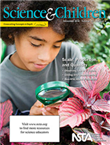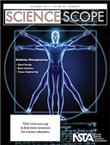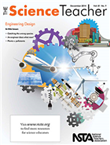NSTA’s K–12 Science Education Journals: December 2014 Issues Online
By Lauren Jonas, NSTA Assistant Executive Director
Posted on 2014-12-12
The titles of this month’s journal articles from the National Science Teachers Association (NSTA) are so fun, you may just feel like you’re getting an early holiday present when you read them: “Elephant Trunks and Dolphin Tails,” “Cinderella Separates a Mixture,” “Not Too Hot, Not Too Cold,” and “An Engineer Does What Now?” But these lighthearted titles represent very serious teaching strategies and lesson plans. Browse through the thought-provoking selections below and learn more about community health and heredity, incorporating engineering design and technology into classrooms, biomedical engineering, the Next Generation Science Standards (NGSS), and other important topics in K–12 science education.
Science and Children
 Young children work at macroscopic scales that are directly observable and move on to those that are too small, too large, too fast, or too slow to observe as they learn.
Young children work at macroscopic scales that are directly observable and move on to those that are too small, too large, too fast, or too slow to observe as they learn.
Featured articles (please note, only those marked “free” are available to nonmembers without a fee):
- Bee-Wild About Pollinators!
- Cinderella Separates a Mixture
- Free – Editor’s Note: Scale, Proportion, and Quantity
- Gliding Into Understanding
- Free – Observing Life in a Square
- Shrieks and Shrills
- Full Table of Contents
Science Scope
 Ebola, vaccinations, and concussions are just some of the health issues making headlines recently. In this issue, we explore health-related topics that are sure to engage students and reinforce the notion that the body is a system of multiple interacting subsystems.
Ebola, vaccinations, and concussions are just some of the health issues making headlines recently. In this issue, we explore health-related topics that are sure to engage students and reinforce the notion that the body is a system of multiple interacting subsystems.
Featured articles (please note, only those marked “free” are available to nonmembers without a fee):
- Inspired by Real Science: Biomedical Engineering for Breast Cancer Research in the Classroom
- Free – No Ordinary Coronary
- Sickle Cell Disease: Relating Community Health and Heredity
- The Big Break: A Module on Biomedical Engineering Principles and Medical Devices
- Full Table of Contents
The Science Teacher
 Engineering has a rich history that goes back at least as far as the ancient metallurgists who transported humanity out of the Stone Age. Twentieth-century engineers gave us everything from radar and television to lunar landings and the internet; the Human Genome Project that radically transformed the life sciences; and improvements in health, sanitation, and medicine that led to a 30-year increase in life expectancy, which surely ranks as one of society’s greatest achievements. By incorporating engineering design and technology into our classrooms, we allow students to apply their developing science understanding to solving problems that are practical, relevant, and important in their daily lives. All of the feature articles in this issue address this important effort.
Engineering has a rich history that goes back at least as far as the ancient metallurgists who transported humanity out of the Stone Age. Twentieth-century engineers gave us everything from radar and television to lunar landings and the internet; the Human Genome Project that radically transformed the life sciences; and improvements in health, sanitation, and medicine that led to a 30-year increase in life expectancy, which surely ranks as one of society’s greatest achievements. By incorporating engineering design and technology into our classrooms, we allow students to apply their developing science understanding to solving problems that are practical, relevant, and important in their daily lives. All of the feature articles in this issue address this important effort.
Featured articles (please note, only those marked “free” are available to nonmembers without a fee):
- An Engineer Does What Now?
- Free – Catching the Wrong Species
- Free – Editor’s Corner: Engineering a New World
- Engineering Design Challenge
- Make Room for Engineering
- Plants v. Pollutants
- Full Table of Contents
Get these journals in your mailbox as well as your inbox—become an NSTA member!
The mission of NSTA is to promote excellence and innovation in science teaching and learning for all.
Follow NSTA
| |
|
|
|
Disclaimer: The views expressed in this blog post are those of the author(s) and do not necessarily reflect the official position of the National Science Teaching Association (NSTA).


